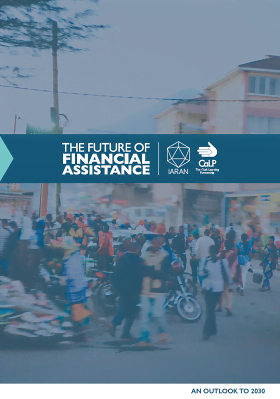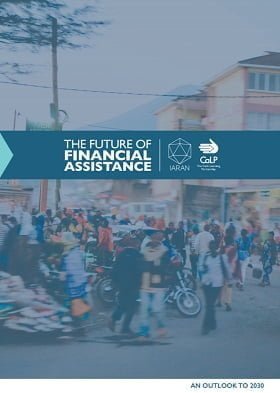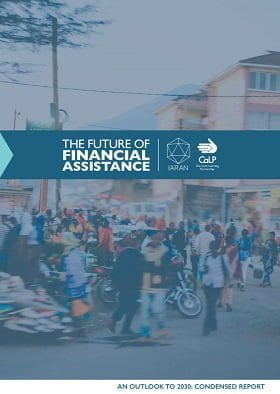About the Future of Financial Assistance Report
In 2019, the Future of Financial Aid mapped out the potential scenarios for how financial assistance might look in 2030, the key drivers influencing these changes, and what this will mean for humanitarian action.
Why is this useful?
Because change is happening rapidly in the humanitarian sector, with the scale-up of Cash and Voucher Assistance (CVA) acting as a further catalyst. These changes have implications for the way humanitarians plan and deliver programmes, and optimize results for crisis affected people.
The report provides support to actors to think through how opportunities and challenges may evolve, and how they could better prepare for the delivery of effective assistance in future.
The Future of Financial Assistance: Key Findings
What will the CVA landscape look like in 2030?
The Future of Financial Assistance report outlines four potential scenarios:
In the control scenario governments lead financial assistance with a high degree of control over other actors and eligibility criteria.
In the chaos scenario end-user trust has been eroded by a lack of coordination and funding for a comprehensive response based on needs and standards.
In the emergent scenario new networks of humanitarian actors drive innovation in a deregulated environment.
In the synergy scenario multiple interoperable modalities for financial assistance are coordinated under an umbrella of common principles and standards.
These scenarios can be used to inform strategic planning, and to ensure that we can continue to meet the needs of crisis affected people in a way that maximizes the impact of limited humanitarian resources.
The piece concludes that (a) significant change is urgently needed – new partners, new tools, new modes of collaboration, (b) change must be drive by what’s needed, not what we’d like to offer and (c) humanitarian actors are one piece of a complex puzzle – we need to work differently with governments, the private sector and with recipients to better understand where we can and must add value.
The report is a must read for humanitarians seeking to deliver more efficient, effective, accountable, people-centred and future-fit financial assistance.
Key Resources

The Future of Financial Assistance: An outlook to 2030
Report
This major publication developed by the CALP Network and IARAN draws on extensive research with a broad range of stakeholders from across the humanitarian sector and beyond, and innovative foresight analysis. The report maps out potential scenarios for how financial assistance might look in 2030, the key drivers influencing these changes, and what this will mean for humanitarian action.

The Future of Financial Assistance – Executive summary
Report
The growing use of cash to meet humanitarian needs is challenging traditional sector and mandate based models, and bringing with it opportunities to work with new partners and tools. With its links to other reforms in humanitarian assistance, such as the push for localisation, participatory approaches, social protection and market based support, cash is being increasingly regarded as a...

The Future of Financial Assistance – Condensed version
Report
The growing use of cash to meet humanitarian needs is challenging traditional sector and mandate based models, and bringing with it opportunities to work with new partners and tools. With its links to other reforms in humanitarian assistance, such as the push for localisation, participatory approaches, social protection and market based support, cash is being increasingly regarded as a...

A New Blueprint for the Future of Financial Assistance
Blog Post
Ahead of our workshop on the Future of Financial Assistance in Amman on 24 and 25 July, Paula Gil Baizan, independent expert and a member of the steering committee for the CALP Network’s Future of Financial Assistance work, encourages us to re-imagine the blueprint upon which we build the future of cash. The CALP Network is working with IARAN to develop a range of scenarios for the...

How Will Financial Assistance Look in 2030? Here are your thoughts so far
Blog Post
In 2030, humanitarian crises and the ways in which humanitarian needs are met will look very different from today. The role of financial assistance is growing: it is estimated that $4.8 billion was delivered in cash and voucher assistance (CVA) in 2018, as well as $686 billion in remittances, while 2.5 billion people in developing countries are covered by social safety nets. As a network of...

The Future of Financial Assistance: Why we wrote it, and where next
Blog Post
The world is changing rapidly. The way we deliver assistance is not. The CALP Network and IARAN’s new report on the Future of Financial Assistance makes clear that (i) significant change is urgently needed – new partners, new tools, new modes of collaboration, (ii) change must be drive by what’s needed, not what we’d like to offer and (iii) humanitarian actors are one piece of a...

Webinar: Help shape the Future of Financial Assistance report
Event
This webinar presented the scenarios and key issues arising from the CALP Network and IARAN's analysis and invited participants' input, ahead of the publication of the Future of Financial Assistance report

Ep. 3. What does the future of financial assistance mean for your work today?
Podcast
In this episode of the CashCast we speak to Meg Sattler from Ground Truth Solutions, Lars Peter Nissen from ACAPS, and Jenny Caswell from GSMA about the changes we should be seeing today, to effectively meet the humanitarian needs of the future.

Future of Financial Assistance Infographics
Presentation
Key drivers of change